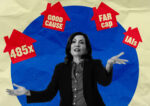Trending
Strategic defaults force scoring fix
With foreclosures soaring — and homeowners with unblemished payment histories abruptly walking away from their houses with no advance warning to lenders — the two major producers of credit scores have begun changing how they evaluate consumers’ risks of default. The revisions could touch you personally the next time you apply for a loan.
In late October, both Fair Isaac, the developer of the FICO score that dominates the mortgage field, and VantageScore Solutions, a joint venture by the three national credit bureaus and marketer of the competing VantageScore, outlined modifications they are making to handle the vast credit disruptions caused by the housing bust, the recession, high unemployment and behavioral changes by consumers.
Overall, credit industry experts agree, consumer creditworthiness has deteriorated in the United States since 2006 — especially among what used to be considered the credit elite, people with the highest scores. For example, a study earlier this year by VantageScore found that the probability of serious delinquency — defined as nonpayment for 90 days or more — had increased by 417 percent among “super-prime” borrowers between June 2007 and June 2009. Default risk during the same period rose by 406 percent for the second-highest rated category of “prime” consumers, and nearly doubled for those at the “near prime” scoring level.
“The driving force behind [the score revisions],” according to Sarah Davies, VantageScore’s senior vice president for analytics and research, is the “significant change in consumer credit repayment behavior” that began during the housing bust and recession.
Not only are borrowers who previously were rated outstanding credit risks far more likely to default today, she said, but many homeowners are defying long-standing credit industry assumptions by going delinquent on their first mortgage payments while simultaneously continuing to pay their credit card balances and second mortgages on time. Strategic defaults — walkaways — by high-score borrowers also have been an unexpected and shocking development, she said.
To adjust its statistical models to these new realities, VantageScore says it conducted intensive research on 45 million active credit files obtained from the databases of its joint venture partners, Equifax, Experian and TransUnion. The research examined the same files — with personal identifiers removed — during set time periods between 2006 and 2009 to capture emerging behavioral patterns associated with defaults on various types of credit accounts. The resulting VantageScore 2.0, which is expected to be rolled out nationwide to lenders in January, focuses in on the subtle warning signs of credit stress that might have been missed earlier — and penalizes or rewards consumers with higher or lower risk scores than they would have received before.
Joanne Gaskin, director of mortgage scoring solutions for Fair Isaac, said her company’s new FICO 8 Mortgage Score is based on similarly exhaustive research into consumer credit behavior changes over the past four years. When used by a lender to rate the risk of new applicants or existing mortgage customers, Gaskin says the Mortgage Score is likely to be anywhere from 15 percent to 25 percent more accurate in detecting signs of future default compared with the standard FICO model.
Though she would not discuss proprietary details about the early warning signs the new score monitors, Gaskin said they include broad patterns such as the following: Say a borrower with a current 720 FICO score might have average balances on a first mortgage, home equity lines and other accounts that are higher than norms pinpointed by the revised scoring software. A 720 FICO is considered a good score by most mortgage lenders — often qualifying for favorable rates and terms.
However, the same applicant might rate just a 680 FICO or lower if the lender used the new mortgage score. The lender would then have a choice: Reject the applicant, quote a higher interest rate on the mortgage or require a larger down payment.
Gaskin said the reverse could also occur: The FICO 8 Mortgage Score could come in higher than the standard FICO — indicating lower risk for the future — in situations where formerly troubled borrowers manage to put themselves back on a healthier credit track.
Experts in the credit industry say the new scoring efforts by Fair Isaac and VantageScore should prove to be a net positive for housing and the mortgage industries if they can do what they claim: spot subtle risk patterns and nascent hints of improvement.
But as a mortgage applicant you should know that your next score might not look anything like the score you thought you had. You might end up getting a better deal — or worse than you wanted — when lenders quote you rates and terms.
Ken Harney is a real estate columnist with the Washington Post.




